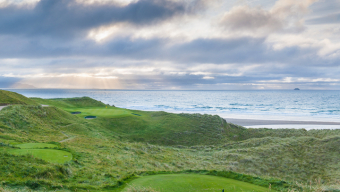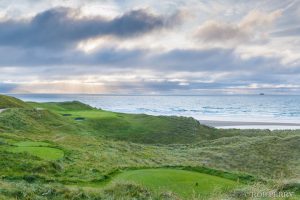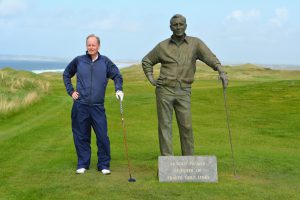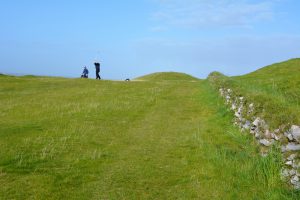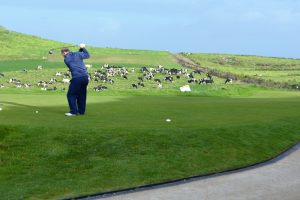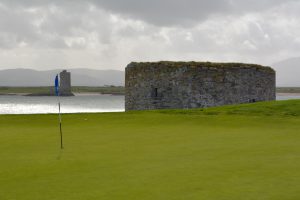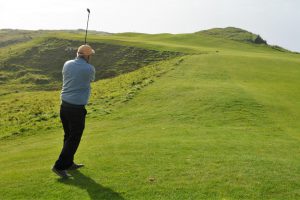Editor’s Note: During this difficult time dealing with the Coronavirus outbreak, leaving golf writers nothing to write about, we decided to revisit some of the places we have gone over the years. Today, we continue our 11-part Irish golf series on the Arnold Palmer-designed Tralee.
(Second of an 11-part series)
WEST BARROW, Ardfert, County Kerry, Ireland — From the moment you step onto the grounds of Tralee Golf Links you feel the presence of the golfing legend Arnold Palmer.
The first clue might be his larger-than-life, eight-foot bronze statue adjacent to the first tee, leaning on a three-wood with a satisfying smile over what he has left behind.
Palmer, who died one year ago today, was the dashing, daring and beloved American golfer who left an enduring mark on the game. His legacy has spread all the way to this little Irish village on the precipice of the Atlantic.
Palmer applied his golf-design vision to Tralee in 1984. It’s one of more than 250 courses he designed worldwide and this was his first (of 11) in Europe. Of them all, there might not be one better. Honestly.
Links golf courses was a departure for the son of a golf professional and greens-keeper from Latrobe, Pa. Palmer grew up playing parkland courses, with little exposure to the links style so preferred in the British Isles. But in 1960, he showed he could adapt and thrive on links, finishing one stroke behind in his first appearance at the Open Championship played at venerable St. Andrews in Scotland.
What his appearance did, credited by many, was revive the prestige of the Claret Jug, the world’s oldest golf championship. Palmer further enhanced his status by winning the Open the next two years, Royal Birkdale (1961) and Troon (1962).
That forever endeared him to the British/European audiences and the love was mutual.
“Arnold had a fantastic reputation,” said Andrew Byrne, Tralee’s general manager. “It was a great coup to get Mr. Palmer here.”
It took nearly a century for the ‘King’ to arrive. Golf had been played at Tralee, a dandy fishing village along the southwest Irish coast, since 1896. The course went through various stages in various places and was even close to closing down during the 1960s.
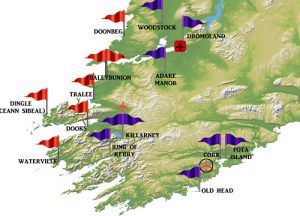 Then in 1980, the club convinced a handful of farmers, with properties flush against the Atlantic, to sell their stakes. Many of the stone walls that separate the lands still weave throughout the Tralee layout.
Then in 1980, the club convinced a handful of farmers, with properties flush against the Atlantic, to sell their stakes. Many of the stone walls that separate the lands still weave throughout the Tralee layout.
Palmer was lined up and his handiwork can measure up with the best courses Ireland has to offer, a must-play for the overseas-player circuit. Tralee is links magnified, glorified and personified. You can see Palmer’s dramatic vision here, especially on the wild and woolly back nine.
“Links courses are what make this part of the world so special,” Bryne said. “The vast majority of (overseas) players are Americans. They play here, Northern Ireland, Scotland, the UK and they want to come back again.”
The course and its surroundings have had their share of history, old and new. Just off the beach, there have been at least 17 shipwrecks, including an unfortunate one from the 1588 Spanish Armada. All the captured sailors were hanged by the governing British.
The crescent-shaped beach just below the first and second holes was the scene for the 1970 movie “Ryan’s Daughter,” which starred Robert Mitchum and Sarah Miles. It won the Academy Award for best cinematography and you can easily see why.
Behind the third hole is an ancient crumbling medieval tower dating to the 1190s. It is flanked by another castle ruins in the distance, across the bay.
In 1916, a German sailor up to no good, was captured on a beach north of the 15th hole, having just exited a U-Boat. He was tried for treason in London and executed. Folks here today aren’t nearly as draconian.
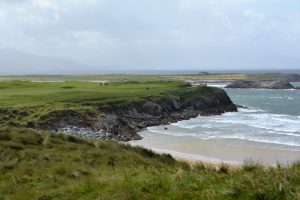
Tralee’s par-5 No. 2, from the tee. You need to take it well left then approach the hole against a strong wind, and the tight right ocean.
You get your first glimpse of Palmer’s vision, perhaps a diabolical one, on the par-5, 584-yard second. It just might be Ireland’s most difficult hole. You drive straight into a strong prevailing wind, steering your ball safely away from the fescue-filled, ocean-edge right side. Inevitably, that leaves a long second shot – virtually unreachable in two – and again the wind can easily carry wayward shots over the right edge. It’s a terrible beauty.
The next hole, a par-3, 194-yarder, is also into the prevailing wind. When it’s howling, a driver is not uncommon. Behind the hole is the ancient tower and slopes that can lead to the rocky shore.
Then there’s the treacherous three, all in a row on the back nine.
No. 11, a par-5, 592-yard hole straight up, is called ‘Palmer’s Peak.’ Your second shot is blind over the hill and your third one might be as well because of a good-size dune between you and the green.
The next hole, a par-4, 460-yarder is impossibly difficult. Your second shot, generally against the wind, must hover over a narrow plateau to the green with dunes to the right and a gigantic crater to the left. If your ball finds that mighty canyon, you might need crampons to enter and a canon to exit.
Another mammoth hole separates you from the green on the par-3, 152-yard 13th. No bailout, no options, you have to clear the hill. The only real safe place is the green. The hillside in back can be helping but you have to be accurate to score on this narrow surface.
The par-3, 199-yard 16th hole (pictured at top), when viewing it from the tee, will forever be filed in your golf-hole memory catalogue. Two bunkers guard the left side and the ocean is hard to the right. It’s a long, tough beautiful approach to this elevated green.
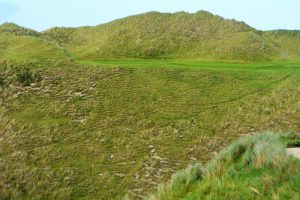
You can’t see the bottom of the yawning crater that separates you from No. 13’s par-3 must-make distant green.
Palmer’s course captivates but Tralee is still evolving. The club is developing a patch of land not far from the clubhouse that it will convert into a six-hole, par-3 course, a practice/driving area and teaching academy. The project is under the supervision of another noted designer, Englishman Dr. Martin Hawtree. It should be ready by next August.
“Our plan is to make par-3 (course) as close to replicating what we have here,” Bryne added.
A paragon plan, for what they have already is special.
TRALEE GOLF LINKS
Location: West Barrow, Ardfert, County Kerry
Opened: 1896
Architects: Originally unknown; Arnold Palmer, rebuild completed in 1984
Type: Links
Tees: Blue (6,948), White (6,643), Green (6,190), Red (5,400)
Par: 72
Green Fees: May-September: $160 (Euros)-$190; November-April: $140
Memorable Holes
No. 2: Par-5, 584 yards. Perhaps Ireland’s hardest. Dogleg right; into wind, ocean tight right.
No. 11: Par-5, 592 yards. “Palmer’s Peak,’ long uphill start, blind second between dunes.
No. 12: Par 4, 460 yards. Impossibly difficult, against wind with narrow plateau to green.
No. 13: Par 3, 152 yards. Gigantic hole between tee and narrow green with backstop dune.
No. 16: Par 3, 197 yards. “Shipwreck,’ (top) long par-3 into wind with ocean right.
THURSDAY: Lahinch





